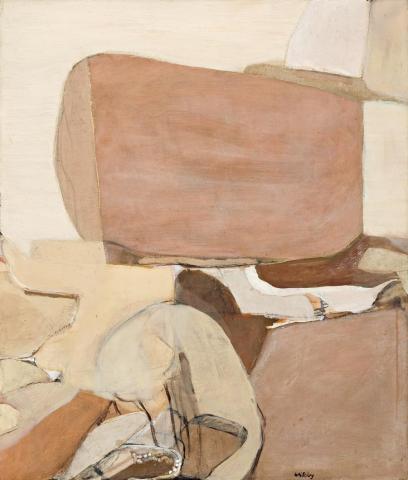SUMMER'S BAY, c.1962
BRETT WHITELEY
oil, tempera and collage on composition board
90.0 x 76.0 cm
signed lower right: Whiteley
signed and inscribed verso: SUMMER'S BAY/ BRETT WHITELEY
Rudy Komon Gallery, Sydney
Allen D. Christensen Collection, California
On loan to the Art Gallery of Western Australia, Perth from September 1979 (label attached verso)
Deutscher Fine Art, Melbourne
Private collection, Melbourne
Awarded the prestigious Italian Travelling Scholarship from the Art Gallery of New South Wales in 1959, Brett Whiteley thus embarked upon his first pilgrimage overseas in early 1960. Based first in Rome, then in Florence, the young artist was immediately seduced by the flat, abstract qualities of the late Byzantine tradition which he perceived in the rich, glowing panels of early Renaissance masters Duccio, Cimabue and Piero della Francesca. Moving to London where he would remain for the next seven years, Whiteley continued to draw inspiration from these Italian memories, combining the ambience of Renaissance painting and sculpture with the earthy hues of Australia (as reflected in the palette of Russell Drysdale) and the semi-erotic abstractions of American artist Arshile Gorky, to create a series of highly sophisticated works such as the present whose curvilinear forms powerfully integrate figuration and abstraction.
Discussing three such paintings which featured in the exhibition of recent Australian painting at Whitechapel Gallery, London in 1961, curator Bryan Robertson observes: 'The paintings were of startling maturity, richness and spiritual and imaginative poise, perfectly at ease in their medium and wholly original. It was hard to believe they were by such a young artist. The images weren't merely sophisticated or knowing, but totally realised in depth, filled with youthful panache and energy, and above all, a personal vision.'1 Not surprisingly perhaps, Whiteley's work created an enormous sensation - the Tate Gallery purchased Untitled Red Painting, 1960, (making him the youngest contemporary artist represented in its collection) and suddenly, the artist's international reputation was launched.
Following the further phenomenal success of his first solo exhibition in London, held at Matthiesen Galleries in March 1962, Whiteley decided to crown the achievement with marriage to his muse and mistress, Wendy Julius. For their honeymoon, the couple travelled to Sigean, a small town on the south coast of France near the Spanish border, where for three months they lived in a deserted farmhouse situated amongst a vineyard which boasted apricot trees, water from a well, fish from a nearby lake, but no electricity. In this lovers' idyll, far from the criticism of the art world and the emotional demands of family and friends, Whiteley produced some of the most elegant and relaxed abstract paintings of his career, as illustrated here by Summer's Bay, c.1962. With its sensual, languid quality evoked by the honey-hued palette and range of textures - from radiant fresco-like glazes to creamy impastos interrupted here and there by slabs of collage - the work encapsulates well that special harmony between humanity and nature so central to the Mediterranean landscape. In a similar vein to his magnum opus from this period, the monumental triptych Summer at Sigean, 1962 (National Gallery of Australia, Canberra), Summer's Bay may, moreover, be appreciated as a homage to Wendy and his marriage - a celebration of the passion and sense of equilibrium which imbued his life at this time.
1. Robertson, B., 'The London Years' in Pearce, B., Brett Whiteley: Art and Life, Thames and Hudson
with the Art Gallery of New South Wales, Sydney, 1995, p.9
VERONICA ANGELATOS
